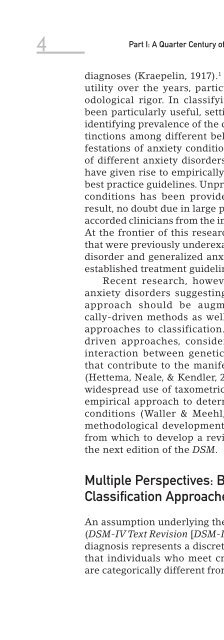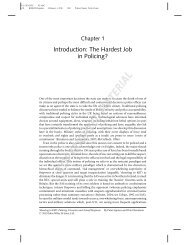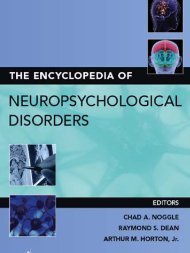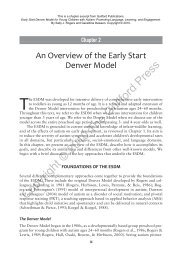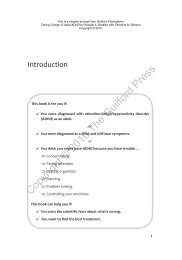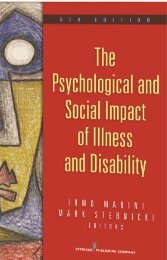Current Perspectives on Anxiety Disorders - Nmhrc.com
Current Perspectives on Anxiety Disorders - Nmhrc.com
Current Perspectives on Anxiety Disorders - Nmhrc.com
- No tags were found...
You also want an ePaper? Increase the reach of your titles
YUMPU automatically turns print PDFs into web optimized ePapers that Google loves.
4Part I: A Quarter Century of the Descriptive Model of Classificati<strong>on</strong>diagnoses (Kraepelin, 1917). 1 This approach has had muchutility over the years, particularly by introducing methodologicalrigor. In classifying anxiety disorders, it hasbeen particularly useful, setting the occasi<strong>on</strong> for researchidentifying prevalence of the c<strong>on</strong>diti<strong>on</strong>s and specifying distincti<strong>on</strong>sam<strong>on</strong>g different behavioral and cognitive manifestati<strong>on</strong>sof anxiety c<strong>on</strong>diti<strong>on</strong>s. Rich theoretical accountsof different anxiety disorders have emerged that, in turn,have given rise to empirically supported interventi<strong>on</strong>s andbest practice guidelines. Unprecedented relief from anxietyc<strong>on</strong>diti<strong>on</strong>s has been provided to anxiety sufferers as aresult, no doubt due in large part to the increased precisi<strong>on</strong>accorded clinicians from the improved classificati<strong>on</strong> system.At the fr<strong>on</strong>tier of this research, specific anxiety problemsthat were previously underexamined, such as social anxietydisorder and generalized anxiety disorder, now have wellestablishedtreatment guidelines.Recent research, however, has emerged in severalanxiety disorders suggesting that the neo-Kraepelinianapproach should be augmented with other empirically-drivenmethods as well as by robust theory-drivenapproaches to classificati<strong>on</strong>. In the case of empiricallydrivenapproaches, c<strong>on</strong>siderable research supports aninteracti<strong>on</strong> between genetic and envir<strong>on</strong>mental factorsthat c<strong>on</strong>tribute to the manifestati<strong>on</strong> of anxiety disorders(Hettema, Neale, & Kendler, 2001). Additi<strong>on</strong>ally, the recentwidespread use of taxometric methods has taken a purelyempirical approach to determining distinct categories ofc<strong>on</strong>diti<strong>on</strong>s (Waller & Meehl, 1997). The c<strong>on</strong>ceptual andmethodological developments have lead to a richer basefrom which to develop a revised classificati<strong>on</strong> system forthe next editi<strong>on</strong> of the DSM.Multiple <str<strong>on</strong>g>Perspectives</str<strong>on</strong>g>: Bridging Gaps inClassificati<strong>on</strong> ApproachesAn assumpti<strong>on</strong> underlying the current diagnostic approach(DSM-IV Text Revisi<strong>on</strong> [ DSM-IV-TR]; APA, 2000) is that eachdiagnosis represents a discrete entity. That is, it is assumedthat individuals who meet criteria for a specific disorderare categorically different from those without the diagnosis.


